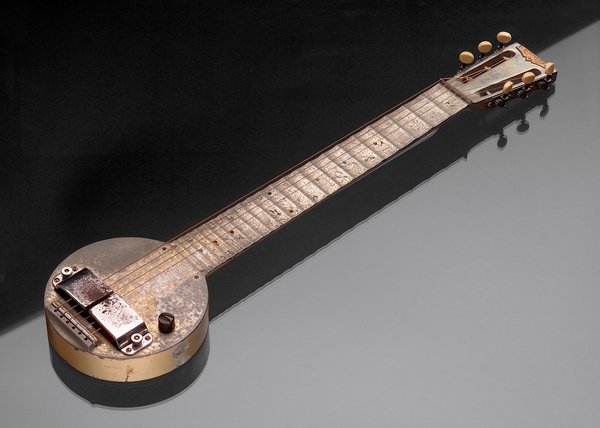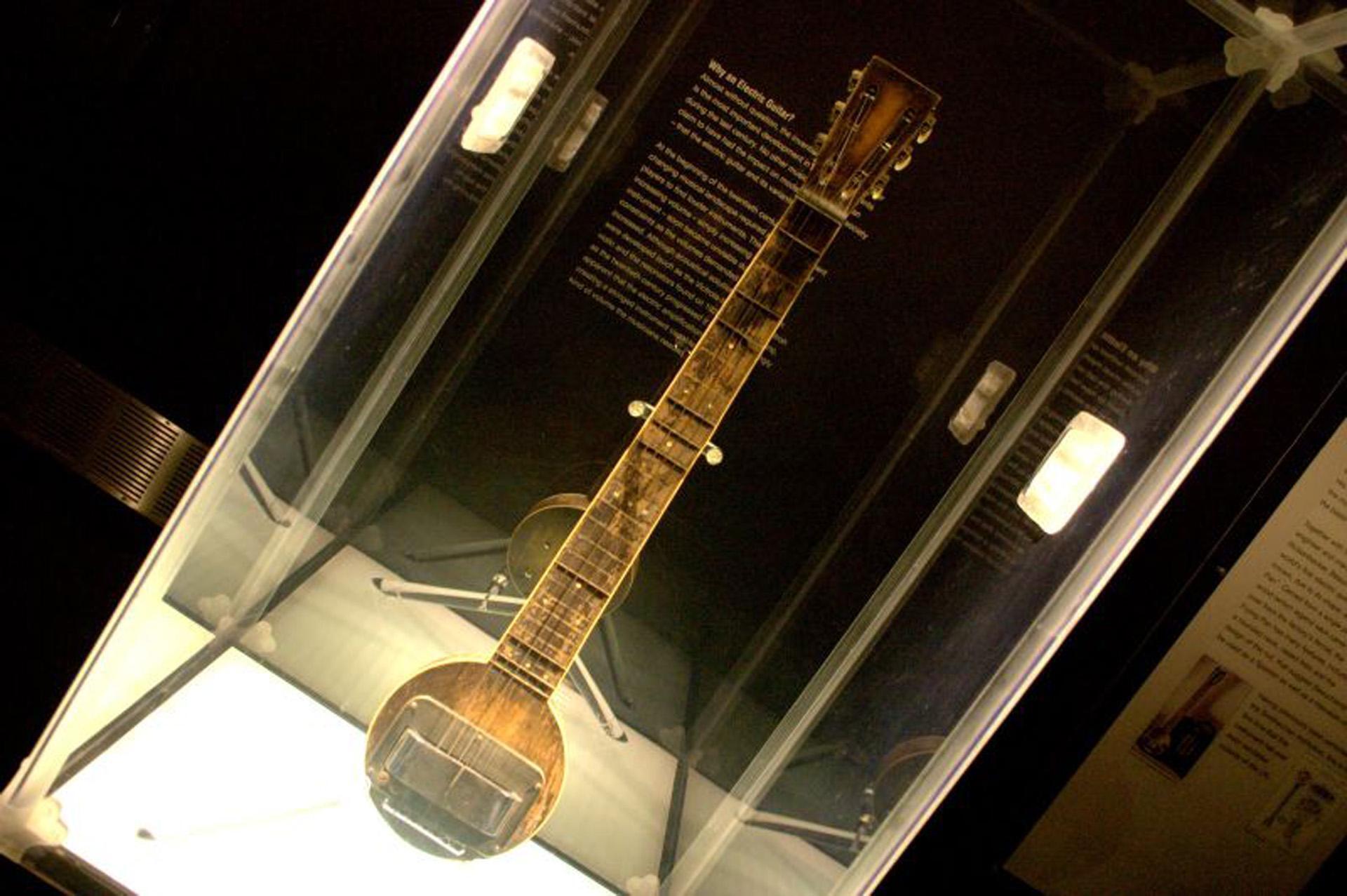The first electric guitar ever made was the Rickenbacker “Frying Pan.” Created in 1931 by George Beauchamp, this guitar revolutionized music.
In the meantime, don't forget to unlock a world of unlimited sound with Amazon Music Unlimited, where over 100 million songs wait at your fingertips. Whether you're working, relaxing, or fueling your creativity, the right track is always just one tap away. Elevate every moment with music that moves you.
Exploring the origins of the electric guitar leads us to the early 1930s, where innovation in sound amplification was paramount. The Rickenbacker “Frying Pan,” named for its distinctive shape, became a pivotal moment in musical history. George Beauchamp, alongside Adolph Rickenbacker, crafted this instrument that allowed guitarists to be heard alongside other amplified instruments.
It catapulted stringed instruments into the spotlight of popular music, forever changing performance and recording techniques. Musicians embraced this new tool for its ability to produce a clear, loud sound without the feedback problems of acoustic guitars with microphones. Diving into this era reveals the daring creativity and technological advancements that gave birth to the modern music scene we know today.

Credit: en.wikipedia.org
The Dawn Of Electrified Strings
The melodious hum of an electric guitar owes its origins to groundbreaking innovations from the early 20th century. Musicians yearning for amplified sound led to a revolution in string instruments, propelling the guitar into a new era. This blog post sheds light on the journey from acoustic to electric, exploring the first forays into amplified guitar design and celebrating the first commercial success: the Rickenbacker ‘Frying Pan’. Let’s tune into the rich history of electric guitars and the milestone moments that shaped modern music.
The Transition From Acoustic To Electric
The leap to electric guitars didn’t happen overnight. It was a gradual progression powered by the desire of musicians to cut through the din of bandstands and raucous crowds. Big bands dominated the 1920s, and acoustic guitarists struggled to project their sound amidst the blaring brass and pounding percussion. Inventive minds began to explore ways to amplify the guitar, leading to designs that would radically alter its role in music.
Early Experiments And Innovations
Initial attempts to electrify the guitar involved rudimentary techniques such as attaching telephone transmitters to instruments. These experiments laid the foundation for the first electromagnetic pickups, capable of converting string vibrations into electrical signals. Electrical engineer Lloyd Loar, in his work with Gibson, played a pivotal role with his early innovations, including experiments with electrostatic pickups. However, it was George Beauchamp who would eventually steer these efforts to fruition.
Rickenbacker ‘frying Pan’: The First Recognized Electric Guitar
In 1931, George Beauchamp collaborated with Adolph Rickenbacker to create the Rickenbacker ‘Frying Pan’, the world’s first commercially viable electric guitar. The name ‘Frying Pan’ came from its circular body and long neck, resembling a kitchen utensil. This landmark creation featured:
- A horseshoe magnet pickup
- An aluminum body
With the advent of the Rickenbacker ‘Frying Pan’, electric guitars began their ascent to becoming a staple in genres ranging from blues to rock ‘n’ roll. The pure, amplified tones it offered became synonymous with the sonic revolution of the 20th century.
Technical Evolution Of The First Electric Guitars
The electric guitar is an icon of modern music, a symbol of rock and roll’s electrifying power. But its origins stretch back to the 1930s, when the first prototypes emerged. At the heart of its evolution were three core technical aspects that transformed the guitar from a folk instrument into a rock powerhouse: the electromagnetic pickup, design and material innovations, and amplification breakthroughs.
Electromagnetic Pickup: The Heartbeat Of Electric Guitars
The crucial element that distinguishes an electric guitar from its acoustic counterpart is the electromagnetic pickup. This component converts the vibration of the strings into an electrical signal that can be amplified. The first electric guitars employed rudimentary pickups, but they laid the groundwork for a new musical revolution.
- Single-coil Pickup: Characterized by their bright and clear sound.
- Humbucker Pickup: Introduced to combat the hum and noise, thus offering a warmer tone.
Design And Material Innovations: From Wood To Steel
Original electric guitars underwent a dramatic shift in both design and materials. Early models featured wooden bodies similar to their acoustic forerunners. However, experimentations soon led to the integration of steel and other materials to enhance sound quality and durability.
| Material | Benefits |
|---|---|
| Wood | Warmth of tone, traditional appearance |
| Steel | Sustain, brightness, resistance to feedback |
Amplification Breakthroughs: Making The Sound Heard
Amplification took electric guitars from intimate settings to arenas. The first electric guitars paired with simple amplifiers, granting musicians the ability to be heard over noisy crowds. The evolution continued with the creation of amplifiers that featured tone controls and effects, paving the way for the intricate soundscapes of modern music.
- Vacuum Tube Amplifiers: Contributed to a rich, warm tone.
- Transistor Amplifiers: Provided more reliability and ease of maintenance.
Cultural Impact And Historical Significance
The first electric guitar ever made didn’t just introduce a new instrument; it heralded a transformation in the soundscape of the 20th century and beyond. Its cultural impact and historical significance cannot be overstated, paving the way for new music styles and becoming a symbol of popular culture. It’s not just an instrument, but an icon of innovation that forever changed the course of music history.
How The Electric Guitar Revolutionized Music
The advent of the electric guitar brought about a seismic shift in music’s evolution. With its ability to amplify sound, musicians could now fill larger venues with the rich tones and sustain of electric strings. This invention propelled musical experimentation, leading to the birth of rock ‘n’ roll, blues, and other genres that form the bedrock of modern music culture.
- Increased volume facilitated the rise of bands and concerts in big arenas.
- Enhanced expression through new playing techniques like bending and distortion.
- Enabled the creation of multi-track recording by isolating the guitar track.
Iconic Musicians And The Electric Guitar
The electric guitar became the go-to instrument for artists looking to make an impact. Names like Chuck Berry, Jimmy Page, and Jimi Hendrix proved the electric guitar’s potential as a force majeure. They didn’t just play music; they used their guitars to tell stories, evoke emotions, and challenge social norms.
| Musician | Contribution |
|---|---|
| Chuck Berry | Pioneering rock ‘n’ roll guitar style |
| Jimmy Page | Pushing the boundaries of electric guitar in rock music |
| Jimi Hendrix | Revolutionizing electric guitar playing techniques |
The Electric Guitar’s Influence On Genres And Subcultures
The electric guitar is not just an instrument but a cultural touchstone that influenced diverse genres and subcultures. It’s the heartbeat of rock, the soul of blues, and the spirit of metal. Its versatility allowed it to cross boundaries and become an emblem of youth rebellion, social movements, and musical exploration.
Subcultures ranging from the leather-clad rockers to the laid-back indie scene have embraced the electric guitar. It is instrumental in the formation of :
- Punk’s raw, energetic riffs.
- Metal’s heavy, distorted power chords.
- Indie rock’s experimental and diverse sonic textures.

Credit: www.openculture.com

Credit: www.sweetwater.com
What Is the History of Electric Guitars Leading Up to the First One Ever Made?
The evolution of electric guitars can be traced back to the early 20th century, when musicians sought to amplify their sound. Innovations in technology led to the development of the first electric guitar, a significant milestone. This journey highlights the significance of electric guitars: a historical look at 1937.
Frequently Asked Questions Of What Was The First Electric Guitar Ever Made
What Was The Very First Electric Guitar?
The very first electric guitar was the Rickenbacker “Frying Pan,” developed in 1931 by George Beauchamp and Adolph Rickenbacker.
Did They Have Electric Guitars In 1947?
Yes, electric guitars were available in 1947. They gained popularity in the music world during the 1930s and 40s.
Who Invented Electric Guitar In 1929?
The electric guitar, as we recognize it, was invented in 1929 by George Beauchamp.
What Was The First Electric Guitar In 1937?
The first electric guitar in 1937 was the Rickenbacker “Frying Pan,” also known as the Electro String Instrument Corporation’s Electric Hawaiian Guitar.
Conclusion
Embarking on the journey through the history of the electric guitar has been fascinating. We’ve discovered that the Rickenbacker “Frying Pan” holds the title of the first electric guitar, paving the way for modern music. This innovation marks a monumental shift in musical expression, forever changing how we experience sound.
Aspiring musicians and history buffs, take note – the electric strings that revolutionized rock started here.
{ “@context”: “https://schema.org”, “@type”: “FAQPage”, “mainEntity”: [ { “@type”: “Question”, “name”: “What was the very first electric guitar?”, “acceptedAnswer”: { “@type”: “Answer”, “text”: “The very first electric guitar was the Rickenbacker \”Frying Pan,\” developed in 1931 by George Beauchamp and Adolph Rickenbacker.” } } , { “@type”: “Question”, “name”: “Did they have electric guitars in 1947?”, “acceptedAnswer”: { “@type”: “Answer”, “text”: “Yes, electric guitars were available in 1947. They gained popularity in the music world during the 1930s and 40s.” } } , { “@type”: “Question”, “name”: “Who invented electric guitar in 1929?”, “acceptedAnswer”: { “@type”: “Answer”, “text”: “The electric guitar, as we recognize it, was invented in 1929 by George Beauchamp.” } } , { “@type”: “Question”, “name”: “What was the first electric guitar in 1937?”, “acceptedAnswer”: { “@type”: “Answer”, “text”: “The first electric guitar in 1937 was the Rickenbacker \”Frying Pan,\” also known as the Electro String Instrument Corporation’s Electric Hawaiian Guitar.” } } ] }As an Amazon Associate, Cleanestor earns from qualifying purchases at no additional cost to you.

